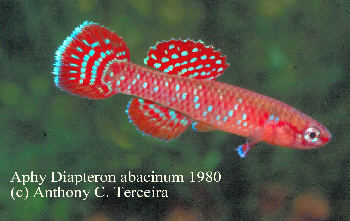Aphyosemion abacinum Huber 1976

Photo of form circulating in the USA in the
1980's.
Photo courtesy of Tony Terceira.
Aphyosemion abacinum Huber 1976

Photo of form circulating in the USA in the
1980's.
Photo courtesy of Tony Terceira.
| Meaning of Name |
Refers to the mosaic pattern on the body | |||
| First Description |
Huber J.H. 1976. Un nouveau Killi du Gabon nord-oriental, Aphyosemion abacinum nov. spec. (Atheriniforme, Cyprinodontidé, Rivuliné). Revue francaise de'Aquariologie 3 (3): 79-82. | |||
| Size |
Males 3·5 - 4, females 3 - 3·5cm. Total length. | |||
| Meristics |
D = 9-10, A = 10-12, D/A = 1-2/1, ll = 31-34 (Huber 1976) D = 9-10, A = 10-12, ll = 31-33 (after Radda & Purzl 1987) | |||
| Karyotype |
| |||
| Sub-Genus | Diapteron | |||
| Group |
| |||
| Synonyms |
| |||
|
Populations
|
| |||
| Type Locality |
Approximately 30 km north (north east?) of Mékambo, Ivindo Basin, north eastern Gabon. | |||
| Distribution |
A fairly limited distribution area on the watershed of the Djoua & Djadie Rivers in northeastern Gabon. | |||
| Habitat |
Two reports seem to contradict - Appears to dislike
flowing water as they are reportedly found in slow flowing - swampy
brooks in rainforest. They are found close to the banks among overhanging
grasses and fallen leaves from the rainforest. | |||
| Distinguishing Characteristics | ||||
| Colour/Pattern Variability | Low | |||
| History |
Discovered by Huber on a collection trip July
/ August 1976 30 km north of Mékambo. Date of collection 22nd
August. Dr.Huber used a bicycle to travel down a track where he discovered
this new sp. A male from this collection was given to Lothar Seegers
to photograph. On the strength of these photos 'phenomenal prices' were
being offered in the USA. | |||
| Breeding Notes |
I kept this sp. in the early '80's but must confess to not doing very well with them. In fact, Diapteron sp. are not my strong point. In 'World of Killies' by Wildekamp the author suggests a pH of 5.5 - 7.0 & soft water of 35-125 ppm. The base should be dark. Various methods can be used including picking the eggs off & putting them into a container containing tank water with a fungal inhibitor such as Acriflavine. Eggs incubated in water hatch in about 20 days.
On hatching the fry are capable of taking newly hatched brine shrimp. Water changes of 90% are recommended for good growth rate. Sexing out occurs after 6 months. Not a very productive sp. | |||
| Diameter of Egg | ||||
| Remarks |
In 1999 this sp. was seen at auctions in the UK. Crossing experiments to date :-
|